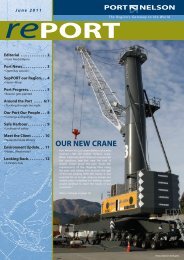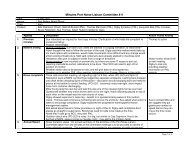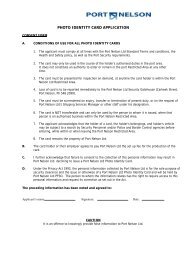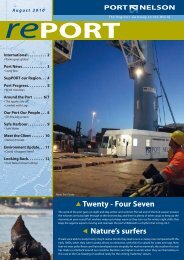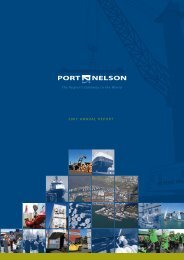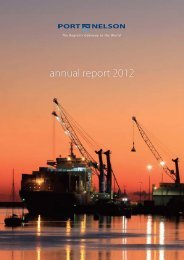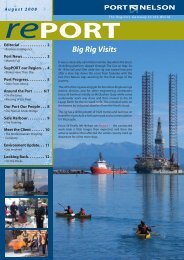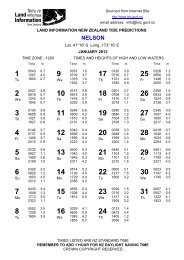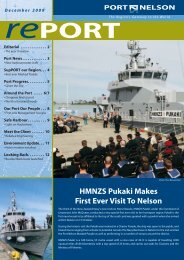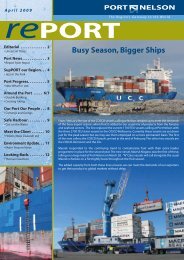Noise Management Plan - Port Nelson
Noise Management Plan - Port Nelson
Noise Management Plan - Port Nelson
You also want an ePaper? Increase the reach of your titles
YUMPU automatically turns print PDFs into web optimized ePapers that Google loves.
<strong>Noise</strong> <strong>Management</strong> <strong>Plan</strong>
CONTENTS<br />
1. INTRODUCTION ............................................................................................................................... 3<br />
2. PLAN OBJECTIVES ............................................................................................................................ 4<br />
3. RELEVANT STATUTORY DOCUMENTS AND REGULATIONS ............................................................. 5<br />
4. RULE INR.40 PORT NELSON INDUSTRIAL AREA NOISE MANAGEMENT .......................................... 6<br />
5. AREA COVERED BY THIS PLAN ......................................................................................................... 6<br />
6. PORT NOISE LIAISON COMMITTEE (PNLC)...................................................................................... 8<br />
7. NOISE MODELLING PROCEDURES ................................................................................................. 12<br />
8. CONTINUOUS NOISE MONITORING PROCEDURES ....................................................................... 12<br />
9. REPORTING PROCEDURES & REQUIREMENTS .............................................................................. 12<br />
10. PROCEDURE FOR MEASURING PORT NOISE ............................................................................. 13<br />
11. COMPLAINT HANDLING & INVESTIGATION PROCEDURES ....................................................... 13<br />
12. SOURCES OF NOISE AND EXISTING NOISE ENVIRONMENT ...................................................... 15<br />
13. NOISE MINIMISATION ............................................................................................................... 18<br />
14. SIGNIFICANT NOISE EVENT INVESTIGATION PROCEDURE ........................................................ 22<br />
15. NOISE AWARENESS AND REINFORCEMENT .............................................................................. 23<br />
16. ALTERATIONS TO THIS PLAN ..................................................................................................... 25<br />
APPENDIX A NOISE CONTOUR PLAN .................................................................................................... 26<br />
APPENDIX B NOISE COMPLAINTS PROCEDURE ..................................................................................... 27<br />
APPENDIX C DEFINITIONS ..................................................................................................................... 28<br />
DATE VERSION CREATED BY APPROVED BY<br />
14/10/2010 1 THOMAS MARCHANT MATT MCDONALD<br />
9/9/2011 2 THOMAS MARCHANT MATT MCDONALD<br />
<strong>Port</strong> <strong>Nelson</strong> <strong>Noise</strong> <strong>Management</strong> <strong>Plan</strong> Page 2
INTRODUCTION<br />
1.1. The <strong>Port</strong> <strong>Nelson</strong> <strong>Noise</strong> <strong>Management</strong> <strong>Plan</strong> 1 (NMP) sets out the long term commitment of <strong>Port</strong> <strong>Nelson</strong><br />
Limited (PNL) to the management of <strong>Port</strong> <strong>Noise</strong> from port related activities. The NMP has been<br />
developed in accordance with the Commissioner’s recommendation on Variation 07/01 (the<br />
Variation), and is a requirement of Appendix 29.A, and Rule INr.40.1 a) of the <strong>Nelson</strong> Resource<br />
<strong>Management</strong> <strong>Plan</strong> (NRMP).<br />
1.2. PNL has prepared a <strong>Port</strong> <strong>Nelson</strong> Environmental <strong>Management</strong> <strong>Plan</strong> (EMP), a management system<br />
that is accredited to the ISO 14001:2004 standard. The NMP has also been incorporated into the<br />
EMP as part of the commitment to noise minimization. The standard is underpinned by the<br />
requirement to continually improve environmental performance; therefore the NMP will be updated<br />
as improvements are made to noise management.<br />
1.3. PNL’s obligations associated with the Acoustic Treatment of <strong>Noise</strong> Affected Properties identified on<br />
the <strong>Port</strong> <strong>Nelson</strong> <strong>Noise</strong> Contour Map are set out in a separate <strong>Port</strong> <strong>Nelson</strong> <strong>Noise</strong> Mitigation <strong>Plan</strong>, a<br />
requirement of Appendix 29.B of the NRMP. The plans are required by rules in the NRMP. The<br />
minimum criteria required by the NMP are specified in the NRMP. If any provisions of the NMP are in<br />
conflict with those provisions then the provisions of the NRMP shall prevail.<br />
1.4. The NMP outlines how PNL will take active steps to comply with<br />
The requirements of Rule INr.40.1(a) of the NRMP, and<br />
the duty contained in Section 16 of the Resource <strong>Management</strong> Act 1991 which provides that:<br />
‘Every occupier of land (including any premises and any coastal marine area), and every person<br />
carrying out an activity in, on, or under a water body or the coastal marine area, shall adopt the best<br />
practicable option to ensure that the emission of noise from that land or water does not exceed a<br />
reasonable level’.<br />
1.5. The areas affected by <strong>Port</strong> <strong>Noise</strong> are shown on the <strong>Port</strong> <strong>Nelson</strong> <strong>Noise</strong> Contour Map (Appendix A). The<br />
<strong>Port</strong> <strong>Nelson</strong> <strong>Noise</strong> Contour Map is based on the energy average of the daily Ldn for 5 consecutive<br />
busy days. It was derived from noise modelling, therefore instantaneous noise levels at a particular<br />
contour line can be expected to be occasionally higher than the representative contour line (see<br />
section 1.6 below and definitions in Appendix C).<br />
1.6. PNL uses the Ldn parameter as the basis of its management. In recognition of sleep interference Ldn<br />
imposes a 10 dBA penalty for noise at night. The Ldn parameter and the development of noise<br />
1 Text in bold is defined in the Meaning of Words (Definitions) – Appendix C<br />
<strong>Port</strong> <strong>Nelson</strong> <strong>Noise</strong> <strong>Management</strong> <strong>Plan</strong> Page 3
contours based on it is considered to be an appropriate method to provide for noise management at<br />
<strong>Port</strong> <strong>Nelson</strong>. These contours have been used to establish land use controls in the NRMP.<br />
2. PLAN OBJECTIVES<br />
2.1. The objectives of the NMP are as follows:<br />
2.1.1. To set out PNL’s commitment to the management, and minimisation of <strong>Port</strong> <strong>Noise</strong>;<br />
2.1.2. To provide information on the sources of noise at the <strong>Port</strong> <strong>Nelson</strong> Industrial Area and the ways this<br />
has been managed to date;<br />
2.1.3. To provide information on the procedures for investigation of significant noise events through<br />
operations;<br />
2.1.4. To describe methods to continue to research, develop and implement noise minimisation<br />
procedures;<br />
2.1.5. To provide a framework for the measurement, monitoring, assessment, and management of <strong>Port</strong><br />
<strong>Noise</strong>;<br />
2.1.6. To provide a framework for the reporting, processing and investigation of noise complaints, and<br />
feedback to the complainant;<br />
2.1.7. To provide information on noise minimisation training, and the noise awareness programme;<br />
2.1.8. To provide a framework for community input into noise management and noise mitigation at <strong>Port</strong><br />
<strong>Nelson</strong>, including contributing to the identification and implementation of the Best Practicable<br />
Option to reduce <strong>Port</strong> <strong>Noise</strong>, through the <strong>Port</strong> <strong>Nelson</strong> <strong>Noise</strong> Liaison Committee (PNLC).<br />
2.2. <strong>Noise</strong> Policy Objectives (From PNL’s Environmental <strong>Management</strong> <strong>Plan</strong>)<br />
The PNL Environmental <strong>Management</strong> <strong>Plan</strong> incorporates this NMP as part of the framework for<br />
addressing environmental effects of port related activities. The EMP noise policy objectives listed<br />
below are accordingly endorsed in both plans.<br />
N2.1.<br />
N2.2.<br />
To ensure that noise emitted from port operations is minimised as far as practicable and to assign<br />
priority to minimisation of one off clangs and bangs.<br />
To ensure that noise at residential locations is minimised as far as practicable by progressively<br />
adopting the best practicable option to limit the emission of noise from all noise-producing<br />
processes and operations at the port.<br />
N2.3 To actively implement the requirements of the NRMP through a <strong>Port</strong> <strong>Noise</strong> <strong>Management</strong> <strong>Plan</strong> and<br />
<strong>Port</strong> <strong>Noise</strong> Mitigation <strong>Plan</strong> once the Variation/<strong>Plan</strong> Change takes effect.<br />
<strong>Port</strong> <strong>Nelson</strong> <strong>Noise</strong> <strong>Management</strong> <strong>Plan</strong> Page 4
N2.4 To comply with the NRMP noise monitoring requirements and verify the accuracy of the noise<br />
model and associated noise contours on a regular basis.<br />
2.3. This NMP is supported by, or operates in conjunction with, the following<br />
i. An Environmental Officer appointed by PNL with responsibility for overseeing noise<br />
management including:<br />
Advising the management of PNL of recommendations of the PNLC and<br />
reporting to the PNLC on implementation of decisions; and<br />
Investigation of options and implementation of procedures for noise<br />
minimisation through port operational procedures and staff and contractor<br />
training; and<br />
Handling and investigation of noise complaints.<br />
ii. PNL’s monitoring and reporting of noise (see section 8 and 9);<br />
iii.<br />
iv.<br />
The <strong>Port</strong> <strong>Nelson</strong> <strong>Noise</strong> Mitigation <strong>Plan</strong>;<br />
The establishment, funding and ongoing effective operation of the PNLC.<br />
3. RELEVANT STATUTORY DOCUMENTS AND REGULATIONS<br />
3.1. The relevant statutory or other documents that have a bearing on this plan are:<br />
The Resource <strong>Management</strong> Act 1991;<br />
The NRMP;<br />
The New Zealand Coastal Policy Statement 1994;<br />
The <strong>Port</strong> <strong>Noise</strong> Standard NZS6809:1999;<br />
Measurement of Sound Standard NZS 6801:1999;<br />
The Building Act 2004;<br />
The Health and Safety in Employment Act 1992;<br />
The <strong>Port</strong> Companies Act 1988;<br />
The Health Act 1956.<br />
<strong>Port</strong> <strong>Nelson</strong> <strong>Noise</strong> <strong>Management</strong> <strong>Plan</strong> Page 5
4. RULE INR.40 PORT NELSON INDUSTRIAL AREA NOISE MANAGEMENT<br />
Rule INr.40 of the NRMP is concerned with the management of noise emitted from the <strong>Port</strong> <strong>Nelson</strong> Industrial<br />
Area and requires the implementation of a <strong>Port</strong> <strong>Nelson</strong> <strong>Noise</strong> <strong>Management</strong> <strong>Plan</strong>, <strong>Port</strong> <strong>Nelson</strong> <strong>Noise</strong> Mitigation<br />
<strong>Plan</strong>, and the establishment of a <strong>Port</strong> <strong>Nelson</strong> <strong>Noise</strong> Liaison Committee.<br />
4.1. <strong>Port</strong> <strong>Nelson</strong> <strong>Noise</strong> <strong>Management</strong> <strong>Plan</strong> (NMP)<br />
This NMP outlines PNL’s continuing commitment to investigate and adopt the best practicable options to<br />
minimise the emission of <strong>Port</strong> <strong>Noise</strong>. Procedures to adopt the best practicable option in order to minimise<br />
<strong>Port</strong> <strong>Noise</strong> are described further in Section 13.<br />
4.2. <strong>Port</strong> <strong>Nelson</strong> <strong>Noise</strong> Mitigation <strong>Plan</strong><br />
The <strong>Port</strong> <strong>Nelson</strong> <strong>Noise</strong> Mitigation <strong>Plan</strong> provides for mitigation of dwellings in the residential zone on a three<br />
tier basis, and is to be implemented by Rule INr.40 and is described in detail in Appendix AP29.B of the NRMP.<br />
It is a separate plan from this NMP and can be viewed on request from PNL or the <strong>Nelson</strong> City Council (NCC).<br />
4.3. <strong>Port</strong> <strong>Nelson</strong> <strong>Noise</strong> Liaison Committee (PNLC)<br />
The PNLC is referred to in Rule INr.40, which requires PNL to establish, maintain and participate in a <strong>Noise</strong><br />
Liaison committee. The PNLC has been in existence since the notification of the Variation in various forms and<br />
has been actively meeting since March 2009 in a manner consistent with the Commissioners’ Recommended<br />
Decision adopted by the NCC. The PNLC is discussed in detail in Section 6.<br />
5. AREA COVERED BY THIS PLAN<br />
5.1. The port noise contours apply to <strong>Port</strong> <strong>Noise</strong> generated within the <strong>Port</strong> Industrial Area, (but excludes<br />
non port noises such as public street traffic noise) as shown below. This NMP however applies only<br />
to the <strong>Port</strong> Operational Area where activities are under direct or close control of PNL. It does not<br />
apply to the areas outside of the <strong>Port</strong> Operational Area or to traffic on the State highway and city<br />
streets.<br />
5.2. Where activities are on land leased to other parties by PNL, only indirect control by PNL is possible.<br />
Activities in this category include seafood-processing plants, transport depots, facilities for boat<br />
building, and maintenance and general port servicing activities.<br />
5.3. <strong>Noise</strong> emissions from these leased areas are controlled by rule INr.37 and INr.38 of the NRMP. Rule<br />
INr. 37 requires that activities in the leased areas of the <strong>Port</strong> Industrial Area do not exceed noise<br />
levels of 65dBA L 10 at their boundary during the day, and 55dBA L 10 at night. Enforcement of this rule<br />
is the responsibility of the NCC. However, as general noise from the <strong>Port</strong> Industrial Area (including<br />
the leased areas) may contribute to measured levels of noise, and therefore requirements for<br />
<strong>Port</strong> <strong>Nelson</strong> <strong>Noise</strong> <strong>Management</strong> <strong>Plan</strong> Page 6
mitigation, PNL has an interest in ensuring overall noise including noise from areas outside its direct<br />
control is kept to the lowest levels practicable.<br />
Figure 1 <strong>Port</strong> <strong>Nelson</strong> Industrial Area 2010<br />
<strong>Port</strong> <strong>Nelson</strong> <strong>Noise</strong> <strong>Management</strong> <strong>Plan</strong> Page 7
6. PORT NOISE LIAISON COMMITTEE (PNLC)<br />
6.1. Role of the PNLC<br />
The PNLC is required to consider all noise issues arising from the port operation and carry out the functions<br />
identified in this NMP and any functions identified in Appendix 29.B. of the NRMP. The PNLC is a functional<br />
interface between PNL and the residents affected by noise from the port. It is recognised that a balance needs<br />
to be struck between the needs of PNL and port users, and those of the residents, and a functioning PNLC is a<br />
cornerstone of this process. The following excerpt is taken from the Commissioners Recommendations on the<br />
Variation, section 11.61:<br />
“The crucial point is that all members of the Committee must have the interests of the proper promotion of the<br />
new scheme of port noise management and mitigation as their focus. Thus, it is not the role of the <strong>Port</strong><br />
representatives on the Committee to try to promote the operation of the <strong>Port</strong> over the interests of the<br />
residents; likewise it is not the role of the residents on the Committee to try to promote their interests over the<br />
efficient and appropriate workings of the <strong>Port</strong>. The Committee is set up to achieve certain outcomes and it is<br />
essential that it works constructively to that end.”<br />
6.2. PNLC Resourcing and Support<br />
6.2.1. PNL will provide secretarial and logistic support for the committee.<br />
6.2.2. PNL will provide a budget that makes adequate provision for the committee to undertake its<br />
functions including the investigation and recommendation of noise minimisation measures<br />
within the <strong>Port</strong> Operational Area.<br />
6.3. Functions of the PNLC<br />
The PNLC primary functions are to:<br />
i. Oversee the implementation of the NMP and the <strong>Port</strong> <strong>Nelson</strong> <strong>Noise</strong> Mitigation <strong>Plan</strong>.<br />
ii.<br />
iii.<br />
Ensure that PNL is made aware of the concerns of its neighbours and other port users and is<br />
meeting community expectations to minimise and mitigate <strong>Port</strong> noise.<br />
Ensure documentation relevant to noise management are up to date and in use in port<br />
operations.<br />
iv. Review current objectives for noise management (see Section 2).<br />
v. Submit programmes to fulfill objectives and associated financial requests to PNL management,<br />
to be considered within PNL’s annual preparation of budgets.<br />
<strong>Port</strong> <strong>Nelson</strong> <strong>Noise</strong> <strong>Management</strong> <strong>Plan</strong> Page 8
vi.<br />
vii.<br />
viii.<br />
Consider all complaints of <strong>Port</strong> <strong>Noise</strong> received and recorded on the PNL’s register of noise<br />
complaints (see Section 11), CRM 2 , SHED 3 reports (see Section 11) and those received by the<br />
<strong>Nelson</strong> City Council and recommend where appropriate further investigations into issues raised<br />
by the complainants, or actions to prevent a recurrence of the complaint.<br />
Review PNL’s performance under the requirements of the Variation, and provide<br />
recommendations to assist PNL in continuing to fulfill these obligations.<br />
The PNLC will consider noise issues arising from port related activities with regard to (in no<br />
particular order of importance):<br />
• PNL’s acceptance of the obligation to manage noise emanating from port<br />
operations;<br />
• The requirement of Section 16 of the Resource <strong>Management</strong> Act 1991 for PNL<br />
and other port users to adopt the best practicable option to ensure the emission<br />
of noise does not exceed a reasonable level;<br />
• The intentions and functions of the PNLC as expressed in the Variation;<br />
ix.<br />
The PNLC is required to carry out the functions given to it by the <strong>Port</strong> <strong>Nelson</strong> <strong>Noise</strong> Mitigation<br />
<strong>Plan</strong>.<br />
6.4. PNLC Composition<br />
The PNLC is required to comprise members as follows<br />
i. Three members appointed by PNL. At the current time the PNL appointed members are:<br />
PNL Environmental Officer;<br />
PNL <strong>Port</strong> Logistics Manager;<br />
PNL Infrastructure Manager.<br />
ii.<br />
iii.<br />
Three members appointed by residents living in the <strong>Port</strong> Hills (the Residents<br />
representatives);<br />
An independent chairperson appointed by the committee (remuneration and expenses<br />
for the Chairman to be met by PNL.)<br />
2 CRM stands for Customer Relationship <strong>Management</strong> and is the internal PNL system to manage noise<br />
complaints.<br />
3 SHED stands for Safety, Health, Environment and Damage report and is the internal PNL system to manage<br />
incidents occurring on site.<br />
<strong>Port</strong> <strong>Nelson</strong> <strong>Noise</strong> <strong>Management</strong> <strong>Plan</strong> Page 9
It should be noted that the PNLC is required by the NRMP to be constituted as a separate committee from the<br />
<strong>Port</strong> <strong>Nelson</strong> Environmental Consultative Committee (PNECC).<br />
6.5. Resident Representative Election Procedure<br />
6.5.1. The process for the election of the resident representatives of the PNLC, including the length of<br />
tenure of their membership on the PNLC, shall be resolved by the committee, and subsequently<br />
recorded in the minutes of that committee meeting.<br />
6.6. Committee Procedure<br />
6.6.1. At its first meeting of the calendar year, the Committee will confirm its chairperson for a period<br />
of two years. The chairperson will be appointed two-yearly thereafter;<br />
6.6.2. In undertaking the business of the PNLC, each member shall in good faith endeavour to achieve<br />
consensus on all issues before the Committee;<br />
6.6.3. The <strong>Port</strong> Operator shall respond in writing to the <strong>Port</strong> <strong>Noise</strong> Liaison Committee within 30 days,<br />
unless the parties agree a different timeframe, to explain its decision with respect to any<br />
recommendation of the <strong>Port</strong> <strong>Noise</strong> Liaison Committee, and how it proposes to implement any<br />
recommendations including timeframes;<br />
6.6.4. The focus of the Committee’s functions shall be the PNLC matters specified in the Variation.<br />
6.7. Committee Meetings<br />
6.7.1. The meetings of the Committee will not be open to the public or media but members will be<br />
free to disclose all matters discussed at a meeting unless it is agreed that a particular matter<br />
will be discussed in confidence, or if there are privacy issues relating to particular properties.<br />
6.7.2. PNL will arrange for the Committee to meet on not less than four occasions each year.<br />
6.7.3. The Committee may invite representatives of other parties to attend and contribute to the<br />
meetings from time to time when discussing issues that either affect or involve the other<br />
parties, and may include, but not limited, to representatives of:<br />
<strong>Nelson</strong> City Council;<br />
<strong>Port</strong> operators and users;<br />
Cargo owners;<br />
<strong>Port</strong> Industrial Area lessees;<br />
Recreational facilities operated within the <strong>Port</strong> Industrial Area;<br />
<strong>Port</strong> <strong>Nelson</strong> <strong>Noise</strong> <strong>Management</strong> <strong>Plan</strong> Page 10
Auckland Point School;<br />
Shipping agents;<br />
Owners and residents of noise affected properties.<br />
6.7.4. The representatives of other parties invited to attend a committee meeting will not have voting<br />
rights.<br />
6.7.5. A special meeting of the Committee may be called by any member, or other person, by contact<br />
with the committee chairperson. The special meeting will be scheduled at the chairperson’s<br />
discretion.<br />
6.8. Committee Reporting<br />
6.8.1. An annual summary of the activities of the PNLC taken from the minutes of the Committee<br />
meetings will be provided to owners and residents of <strong>Noise</strong>-affected properties, as defined by<br />
the NRMP (refer to Appendix C – Definitions). The summary will also be provided to any<br />
member of the public upon request.<br />
6.8.2. A summary of PNLC minutes will be available on the PNL website one month after the meeting<br />
is held.<br />
<strong>Port</strong> <strong>Nelson</strong> <strong>Noise</strong> <strong>Management</strong> <strong>Plan</strong> Page 11
7. NOISE MODELLING PROCEDURES<br />
7.1. PNL has produced a <strong>Port</strong> <strong>Nelson</strong> <strong>Noise</strong> Contour Map shown in Appendix A based on the energy<br />
average of the daily Ldn for 5 consecutive busy days. In accordance with AP29.A of the NRMP the<br />
contour map is required to be updated on an annual basis for the first five years, and every two years<br />
thereafter. The port noise contours are also required to be modelled at 1 dB intervals between 55<br />
dBA Ldn and 70 dBA Ldn.<br />
7.2. An annual update of noise modelling information will be made available to owners of <strong>Noise</strong>-affected<br />
properties, as defined by the NRMP (refer to Appendix C – Definitions) for the first five years and<br />
every two years thereafter.<br />
7.3. PNL will carry out monitoring as necessary to calibrate and ensure that the <strong>Port</strong> <strong>Noise</strong> Contour Map<br />
provides as accurate modeling of <strong>Port</strong> <strong>Noise</strong> using a busy five day operating scenario.<br />
8. CONTINUOUS NOISE MONITORING PROCEDURES<br />
8.1. PNL has installed a continuous noise monitor in accordance with Appendix 29.A.2 of the NRMP, at<br />
the location shown on the map in Appendix A.<br />
8.2. As required by AP29.A.2 of the NRMP PNL will maintain at its expense the sound level monitoring<br />
equipment and shall arrange for a suitably qualified person to perform continuous monitoring of<br />
noise emanating from port activities for at least the first five years. The monitoring equipment is<br />
required as a minimum record noise level statistics in 15 minute periods so that the Leq, Lmax and<br />
L90 noise parameters can be determined for each 15 minute period.<br />
8.3. The monitoring equipment will be capable of recording the actual sound when a pre-set threshold or<br />
set of thresholds is exceeded, so that the sound can be listened to at a later time. Recordings will be<br />
kept for a minimum of six months.<br />
9. REPORTING PROCEDURES & REQUIREMENTS<br />
9.1. PNL will provide the results of the sound level monitoring to the NCC and PNLC on a monthly basis.<br />
The results will be in summary form showing Leq, Lmax and calculated Ldn levels within two weeks<br />
of the end of each month. Significant <strong>Port</strong> <strong>Noise</strong> emissions will be highlighted and correlated with<br />
port activity, wind speed and wind direction.<br />
9.2. When sound level monitoring indicates that <strong>Port</strong> <strong>Noise</strong> may be exceeding 65 dBA Ldn or 65 dBA<br />
Leq (15 min, 10pm-7am) at properties that are not shown on the <strong>Port</strong> <strong>Nelson</strong> <strong>Noise</strong> Contour Map as eligible<br />
for mitigation under Section AP29.B.1 of Appendix 29.B of the NRMP, the results of monitoring will<br />
<strong>Port</strong> <strong>Nelson</strong> <strong>Noise</strong> <strong>Management</strong> <strong>Plan</strong> Page 12
e recorded, investigated and reported to the PNLC. The investigation will identify as far as possible<br />
those properties receiving <strong>Port</strong> <strong>Noise</strong> at or above such levels.<br />
9.3. Copies of this plan, and all reports, minutes, and recommendations considered or made by the PNLC<br />
and PNL, are to be held at the offices of PNL and the NCC and will be made available to members of<br />
the public on request.<br />
10. PROCEDURE FOR MEASURING PORT NOISE<br />
<strong>Port</strong> <strong>Noise</strong> is required to be measured as follows (taken from AP29.A.3 of the NRMP):<br />
(a) in accordance with NZS 6801:1999 Acoustics - Measurement of Sound, and assessment shall be in<br />
accordance with NZS 6809:1999 Acoustics - <strong>Port</strong> <strong>Noise</strong> <strong>Management</strong> and Land Use <strong>Plan</strong>ning, provided that:<br />
i) subject to sub-clause (b) i) of this clause, the Rating Level described in clause 7.3 of NZS 6809:1999<br />
shall be determined for the sole purpose of defining any Leq (15 min) sound level, required for the<br />
purposes of Appendices 29.A and 29B (NRMP); and<br />
ii) adjustments for any special audible characteristic to any Leq (15 min) made in accordance with clause<br />
7.3 and A6 of NZS 6809:1999 shall, except for audible warning devices, not apply to noise from log<br />
and container handling activities. The above exception for log and container handling activities shall<br />
also apply to audible warning devices on ships where there is no practical alternative for safety<br />
reasons.<br />
(b) For the purpose of comparison with noise criteria specified in Appendix 29.B (NRMP) the following will<br />
apply:<br />
i) In assessing any Leq (15 min) sound level between 10pm and 7am the following day, one ship visit of<br />
up to five days duration shall be deemed to be one occasion.<br />
11. COMPLAINT HANDLING & INVESTIGATION PROCEDURES<br />
11.1. <strong>Noise</strong> complaints can be lodged with either NCC or PNL. Complaints lodged directly to PNL enable<br />
immediate action to be taken towards mitigating the source of noise. Appendix B sets out the<br />
procedure for noise complaints lodged with PNL. A complaint may be lodged via telephone,<br />
facsimile, letter or email. PNL considers that the complaints process is a useful way to receive<br />
information from affected parties that may lead to the reduction of <strong>Port</strong> noise. This occurs not only<br />
at the time of the complaint, but as part of the overall aim to minimise <strong>Port</strong> noise. Information<br />
provided by complainants is used to determine the sources of <strong>Port</strong> noise, and for correlation with<br />
readings from the continuous noise monitor.<br />
<strong>Port</strong> <strong>Nelson</strong> <strong>Noise</strong> <strong>Management</strong> <strong>Plan</strong> Page 13
11.2. PNL will maintain a register of noise complaints and report the details of complaints and action taken<br />
to investigate and resolve complaints to the PNLC at the earliest opportunity. The register of noise<br />
complaints will be consistent with the following:<br />
i. Record the details of the name and address of the complainant and the time and date of<br />
the complaint;<br />
ii.<br />
Record a description of the noise, the estimated length of time that the noise occurred<br />
and identify, if possible, the source of the noise;<br />
iii. Record of the noise levels from the continuous noise monitor, including; <strong>Noise</strong> events 4 ,<br />
Short report 5 , and Half second Sound Pressure Level 6 ;<br />
iv.<br />
Identify <strong>Port</strong> operations occurring around the time of the complaint;<br />
v. Record the details of what vessels were in <strong>Port</strong> at the time, and at which berth they were<br />
located;<br />
vi.<br />
vii.<br />
viii.<br />
ix.<br />
Record the wind speed and wind direction;<br />
Take steps to investigate the noise complaint as soon as practicable;<br />
Report back to the complainant and provide details of complaint to the NCC<br />
Environmental Officer;<br />
Record the steps taken to investigate the noise complaint and to resolve or mitigate the<br />
noise issue in the noise register;<br />
11.3. PNL will report the details of complaints and action taken to investigate and resolve complaints to<br />
the PNLC at the earliest opportunity.<br />
11.4. The process of investigation may be undertaken through the PNL internal Safety, Health,<br />
Environment and Damage reporting and investigation (SHED Report) process at the discretion of the<br />
Infrastructure Manger.<br />
11.5. The <strong>Nelson</strong> City Council will take such steps as necessary to encourage any noise complaints to be<br />
made directly to it, and the NCC Environmental Officer will investigate the complaint as soon as<br />
circumstances allow and will advise PNL of the complaint.<br />
11.6. When a noise complaint is received, PNL will as soon as practicable advise the NCC if the complaint is<br />
not received through the Council.<br />
4 Significant noise event profile displaying measurement of Leq, Leq max, SPL max, event spectra and wind<br />
speed.<br />
5 Statistical report showing measurement of Leq, L90, and SPL max in 15 minute intervals.<br />
6 Sound Pressure Level measurements displayed at half second intervals<br />
<strong>Port</strong> <strong>Nelson</strong> <strong>Noise</strong> <strong>Management</strong> <strong>Plan</strong> Page 14
12. SOURCES OF NOISE AND EXISTING NOISE ENVIRONMENT<br />
To understand the noise environment at <strong>Port</strong> <strong>Nelson</strong>, noise observations, measurement and modelling has<br />
been undertaken by an acoustic engineer (Hegley Acoustics Consultants Limited). As part of the modelling it<br />
was necessary to identify and quantify dominant noise sources.<br />
The following noise sources have been identified.<br />
12.1. Container Handling<br />
Container handling activities include:<br />
i. Unloading containers delivered to the <strong>Port</strong> by road using lift-trucks. This mainly occurs<br />
during the day (receiving and delivery);<br />
ii.<br />
iii.<br />
iv.<br />
Moving containers to and from ship side during vessel working using trucks and lift-trucks<br />
(marshalling);<br />
Loading full containers and unloading empty containers using cranes (stevedoring);<br />
Loading and unloading containers into RoRo vessels (stevedoring);<br />
v. Storage of refrigerated containers with their cooling systems running;<br />
vi.<br />
vii.<br />
viii.<br />
ix.<br />
Loading and unloading of containers with break bulk cargo;<br />
Container washing and (testing) ‘pre-tripping’;<br />
Lashing bars dropped on deck - dropping twist locks on deck or wharf;<br />
Transport of containers within the <strong>Port</strong> Operational Area;<br />
x. Undertaking repairs on containers;<br />
xi.<br />
Containers blowing over during wind events.<br />
12.2. Cranes<br />
Crane activity noise sources include:<br />
i. Mobile Harbour Crane - whining sound from the crane rope drum operation;<br />
ii.<br />
iii.<br />
iv.<br />
Ship’s own crane or gantry - movement warning devices emit a penetrating sound;<br />
Preparing cargo for lifts - removal of container lashing bars;<br />
lashing bars dropped on deck - dropping twist locks on deck or wharf;<br />
<strong>Port</strong> <strong>Nelson</strong> <strong>Noise</strong> <strong>Management</strong> <strong>Plan</strong> Page 15
v. Operation of spreaders - the impact noise between lifting spreader and container;<br />
vi.<br />
vii.<br />
viii.<br />
ix.<br />
Placing the cargo on the wharf or on the ship - penetrating impact noise caused by the<br />
container landing on the wharf and on the ship.<br />
Lifting of hatch lids and placement on wharf or ship;<br />
Sliding containers into the guides on the vessel;<br />
Lifting of logs and placing into ship holds, particularly into an empty hold.<br />
12.3. Container Handling Forklifts<br />
Forklift operations that generate noise include:<br />
i. Engine revving;<br />
ii.<br />
iii.<br />
iv.<br />
Impact of spreader or forks against the container or cargo;<br />
Placement of the container on the wharf or truck;<br />
Reverse warning indicators.<br />
12.4. Ships at Berth<br />
This is noise which continues for the whole time, day and night, that the vessel is in port and is mainly caused<br />
by the generators which provide power to run winches, refrigeration plants, integrated refrigeration units,<br />
heating and lighting, etc. This is a fairly constant noise for the full duration of the ship's stay on the berth. The<br />
use of ships’ horns is another source of noise. The noise level produced by the ships are beyond the direct<br />
control of PNL but is included in the calculation of the port noise contours as part of the total port noise<br />
experience and is managed through the provisions of the NRMP.<br />
12.5. Container Refrigeration Units (Reefer Units)<br />
Refrigeration containers have a cooling unit built in. They are used in two main areas, full containers awaiting<br />
shipment and empty containers being prepared in the empty container yard. Their positions are fixed because<br />
the power is fed underground to units that accommodate up to 16 containers. The port has up to 630 power<br />
points available for containers at various locations. Up to 128 of these are used for testing empty containers.<br />
Empty containers are tested for a period between 6 and 12 hours depending on the design.<br />
Full containers are on power for an average of 2 days prior to the estimated arrival time of the ship. The power<br />
to frozen cargo cuts on and off automatically whilst power to chill containers is continuous.<br />
<strong>Port</strong> <strong>Nelson</strong> <strong>Noise</strong> <strong>Management</strong> <strong>Plan</strong> Page 16
12.6. Container Repair<br />
The repair of damaged containers takes place during daytime hours in the Empty Container Yard. General steel<br />
repair work also includes grinding and hammering of steel members back into shape which causes a hollow<br />
impact sound and grinding noise.<br />
12.7. Trucks<br />
Cargo arrives and departs from the <strong>Port</strong> by road trucks that travel through the operational areas along set<br />
routes to fixed areas where they are unloaded by forklifts or in the case of logs, by log loaders. Container<br />
trucks stop at the port entrance for documentation and break-bulk cargo trucks move direct to the storage<br />
areas or direct to shipside.<br />
Logs are initially scaled at the north end of Graham Street before the truck travels to the storage area where<br />
the logs are offloaded by log-loaders. An impact noise is also generated when the metal frames that hold the<br />
logs in place in transit are lowered on log trucks after the logs have been removed.<br />
The main container truck exchange area is located on the north side of the container storage area adjacent to<br />
the tug berth.<br />
Road trucks and mafi-trucks are used during the stevedoring and marshalling operations to transport<br />
containers to and from the storage area from and to the ships or cranes. The route they take is circular<br />
between the storage area and shipside<br />
It should be noted that noise from trucks and machinery moving on public roads is not included as port noise.<br />
12.8. Log Loaders<br />
Log loaders are similar to forklifts and are large diesel driven machines with hydraulically controlled beaks that<br />
can lift 20 tonnes of logs. Their initial duty is to offload the trucks of logs on arrival and to place the logs into<br />
storage rows. They are used to either move the logs to shipside during loading or onto trucks that transport<br />
the logs to shipside where another log loader offloads and places the logs into bunks ready for the stevedore<br />
to lift onto the ship.<br />
The log loaders generate noise especially when applying revs to lift the heavy loads. An associated noise can be<br />
logs rolling from the stockpile when log loaders are removing logs from the pile. The log trucks moving back<br />
from shipside rattle and bang. A booming sound may occur when logs are first placed in large empty holds of<br />
ships.<br />
12.9. Abrasive Blasting<br />
The ship repair industry need to undertake abrasive blasting of hulls to remove the paint ready for recoating<br />
and is a particularly noisy operation. The abrasive blasting mainly occurs at the slipway at an elevated location.<br />
<strong>Port</strong> <strong>Nelson</strong> <strong>Noise</strong> <strong>Management</strong> <strong>Plan</strong> Page 17
The Slipway is outside of the <strong>Port</strong> Operational Area (but within the <strong>Port</strong> Industrial Area) and is managed by a<br />
lease holder (Calwell Slipway, <strong>Nelson</strong> Ltd).<br />
The slipway has a resource consent that permits a higher level of noise at its boundary than the other leased<br />
areas within the <strong>Port</strong> Industrial Area, to enable the abrasive blasting to take place (see section 5 for details).<br />
13. NOISE MINIMISATION<br />
<strong>Noise</strong> reduction measures implemented to date include changes in land use within the port, adoption of a<br />
Ships Berthing Code of Practice, investigation and where possible adoption of new technology and staff<br />
awareness programmes. The following noise reduction methods are currently in place at PNL.<br />
13.1. <strong>Management</strong> changes to minimise noise have included:<br />
i. Preventing horns being blown as a signal between log loader and truck;<br />
ii.<br />
iii.<br />
iv.<br />
Moving the log storage closer to the loading wharf and further away from the residential<br />
area;<br />
Day time activities utilise zones closer to residential areas e.g. a new location for the<br />
empty container yard;<br />
Requesting shipping companies to investigate modifying generators/funnels of ships;<br />
v. New land acquired and redeveloped to provide log storage;<br />
vi.<br />
vii.<br />
viii.<br />
Modification to crane spreaders e.g. Height Indicator System for reduced impact between<br />
container and spreader;<br />
Berth allocation policy to use Brunt Quay as the preferred berth over Main Wharf South<br />
for container vessels;<br />
Purchasing decision policy to acquire quieter plant and equipment e.g. container handling<br />
forklifts, log loaders, trucks and trailers.<br />
13.2. Container Handling, Stevedoring and Marshalling Code of Practice<br />
Activities that take place at night are limited to those essential to service ships to facilitate their efficient use of<br />
the port facilities. The following measures are in place or have been identified to be included in future<br />
stevedoring codes of practice:<br />
i. Awareness training will be provided for all stevedoring and marshalling staff and all new<br />
staff will be briefed on noise, particularly noise at night;<br />
ii.<br />
Staff input into methods of improving the noise environment will be encouraged;<br />
<strong>Port</strong> <strong>Nelson</strong> <strong>Noise</strong> <strong>Management</strong> <strong>Plan</strong> Page 18
iii.<br />
iv.<br />
Regular meetings will be held between stevedores and cargo planners to minimise<br />
unnecessary movements at night;<br />
Records will be kept of improvements to minimise movements;<br />
v. Stevedoring Foremen will audit the noise being generated during the operations, take<br />
steps to mitigate the noise where practical, and will monitor staff performance for future<br />
staff allocation;<br />
vi.<br />
vii.<br />
viii.<br />
ix.<br />
Container twist locks to be placed in holding boxes rather than dropped onto the deck of<br />
the ship;<br />
Where practicable the twist locks to be taken off the containers at wharf side rather than<br />
on the ship (this reduces the potential of accidental dropping of the steel holding units<br />
and stops the container about a metre above the wharf to enable the twist locks to be<br />
removed and the container lowered slowly to the wharf, reducing the landing impact);<br />
High stacking forklifts spreader hydraulic lift control to be fitted with pressure reducing<br />
valve to delay the initial lift speed and avoid the impact when the spreader engages the<br />
container;<br />
Reversing indicators on forklifts are disengaged at night and replaced with reversing<br />
strobe lights;<br />
x. <strong>Plan</strong>t operators to complete a checklist of equipment at the start of each shift to include<br />
noting any noise generating faults;<br />
xi.<br />
xii.<br />
xiii.<br />
Radios will be used for communications instead of verbal instructions;<br />
Use of horns will be limited to safety purposes;<br />
The log marshalling company will comply with the Log Storage Code of Practice.<br />
13.3. Ships at Berth Code of Practice<br />
The following mitigation measures are in place or have been identified to be included in future ships at berth<br />
codes of practice:<br />
i. Berth ships with the major noise source, e.g. generators or ventilation fans, directed<br />
away from the residential area, unless the ship is required to be berthed on the opposite<br />
side for loading purposes;<br />
<strong>Port</strong> <strong>Nelson</strong> <strong>Noise</strong> <strong>Management</strong> <strong>Plan</strong> Page 19
ii.<br />
iii.<br />
Maintain and display in the Duty Pilots office a register of noisy ships and their best berth<br />
and direction so that they may be identified prior to entering port and berthed as above.<br />
The berth selection will be subject to operational constraints;<br />
Seek proactive support from regular shipping lines to minimise noise from vessels by:<br />
Endeavouring to achieve the loading at other ports that enables the vessel to be<br />
berthed as required in i) above;<br />
Investigating means of reducing the noise emitted from overly noisy motors,<br />
generators, fans or loading gear;<br />
Investigating means of muting the noise emitted from the ship’s loading equipment<br />
warning bells or sirens without compromising their safety purpose;<br />
iv.<br />
Loudspeaker systems shall not be used on ships in port for any reason other than for<br />
safety warnings;<br />
v. Ship horns shall only be used when testing is required prior to departure and if possible<br />
the testing shall be undertaken during day hours, 0700-2200. The exceptions are :<br />
Cruise Liners upon arrival or departure to relay a welcome and thank you signal;<br />
Where the horns are required for navigational safety, such as in fog.<br />
13.4. Cargo Transport and Storage Code of Practice<br />
The following mitigation measures are in place or have been identified to be included in future cargo transport<br />
and storage code of practice where practical:<br />
i. Receiving containers at the port and the delivering onto the customer’s road freighting<br />
company’s truck will generally occur during the hours 0700 - 2200, unless delivering<br />
direct to the ship.<br />
ii.<br />
iii.<br />
iv.<br />
Placing as many reefer (refrigerated) containers on power with their motors positioned<br />
facing away from the <strong>Port</strong> Hills as practical.<br />
Placing stacks of empty containers, where practical, to form a buffer between the <strong>Port</strong><br />
Hills and port operations, subject to obtaining a balance between noise mitigation and<br />
adverse visual effects, and determining that there is no adverse effects due to deflection<br />
of noise.<br />
Empty container yard, packing containers and quarantine work will generally be day<br />
operations, 0700 – 2200, other than during peak times when the operations must<br />
<strong>Port</strong> <strong>Nelson</strong> <strong>Noise</strong> <strong>Management</strong> <strong>Plan</strong> Page 20
continue to achieve completion prior to the ship visit. However, pre-tripping (checking<br />
they will hold the required temperature) of reefer containers is a 24 hour operation.<br />
v. Regular meetings will be held between cargo planners and stevedores and to minimise<br />
unnecessary movements at night.<br />
13.5. <strong>Plan</strong>t, Equipment and Development Code of Practice<br />
<strong>Plan</strong>t and equipment used in the <strong>Port</strong> Operational Area is subject to the following measures:<br />
i. <strong>Plan</strong>t and equipment tenders shall include noise levels as an important factor and this will<br />
be considered when deciding which offer/quotation/tender to accept.<br />
ii.<br />
iii.<br />
iv.<br />
<strong>Plan</strong>t and equipment shall be regularly maintained to keep noise emissions to a minimum<br />
and repaired at an early date whenever damage causes increased noise.<br />
Daily start-up checklist for operators includes a check on anything that the operator<br />
identifies as noisy and/or has suddenly become noisy.<br />
Safety warning devices shall where practical minimise noise. For example:<br />
Disengaging the reversing indicators at night and replacing them with reversing<br />
strobe lights for safety;<br />
v. The effect of noise on residents shall be a factor when considering alternatives for port<br />
development.<br />
13.6. <strong>Port</strong> Users<br />
PNL will continue to encourage companies working within the <strong>Port</strong> Area to be aware of noise issues through:<br />
i. Contractor inductions;<br />
ii.<br />
Updates to the Common User Protocol.<br />
13.7. <strong>Port</strong> <strong>Noise</strong> Network<br />
i. The PNL Environmental Officer will maintain regular communication with <strong>Port</strong>s across<br />
New Zealand and internationally to share best practice in minimising port noise;<br />
ii.<br />
iii.<br />
Maintain regular contact with providers of specialised port equipment and ensure noise<br />
reducing modifications are adopted as soon as is practicable;<br />
Keep up to date with New Zealand Standards for industry and adopt applicable best<br />
practice.<br />
<strong>Port</strong> <strong>Nelson</strong> <strong>Noise</strong> <strong>Management</strong> <strong>Plan</strong> Page 21
13.8. Audits and Performance Measurement<br />
i. The noise minimisation objectives of this plan may be audited externally as part of the<br />
<strong>Port</strong>s environmental management programme accredited to ISO 14001;<br />
ii.<br />
iii.<br />
Develop performance measures for external audit with the objective of continuous<br />
improvement to ISO 14001 accreditation standards;<br />
Revise the PNEMP noise policy to align with the NMP.<br />
14. SIGNIFICANT NOISE EVENT INVESTIGATION PROCEDURE<br />
The nature of operations at <strong>Port</strong> <strong>Nelson</strong> in conjunction with the proximity of the <strong>Port</strong> Hills residential area<br />
means that at night residents may be exposed to sudden clangs and bangs which cause them to be woken. In<br />
acoustic terms these clangs and bangs are represented by the Lmax parameter. Lmax is the A frequency<br />
weighted maximum sound level in decibels over a particular time frame (normally 15 minutes).<br />
14.1. Significant <strong>Noise</strong> Event<br />
PNL is committed to minimising the clangs and bangs associated with operations, particularly at night. To<br />
reduce the occurrence of noise events which exceed 85dBA Lmax (modeled at the 65 dBA Ldn contour line on<br />
the <strong>Port</strong> <strong>Noise</strong> Contour Map) noise levels 7 PNL will:<br />
14.1.1. Ensure all relevant staff receive induction and training in the importance of noise minimisation (see<br />
Section 13.6, and 15);<br />
14.1.2. Work closely with other port users to ensure all noise sources are kept to a minimum in particular<br />
Lmax events exceeding 85 dBA.<br />
14.1.3. Irrespective of any complaint, whenever the continuous sound level monitor indicates that <strong>Port</strong><br />
<strong>Noise</strong> has exceeded 85dBA Lmax 2200hrs – 0700hrs PNL will:<br />
i. Identify the source of the Lmax exceedance event and investigate its cause. Video<br />
monitoring footage of port activity will be used where possible to investigate the source<br />
of <strong>Port</strong> <strong>Noise</strong> in order to reduce the occurrence of significant noise;<br />
ia<br />
ii.<br />
Record and analyse noise levels from the continuous noise monitor, including <strong>Noise</strong><br />
events (including sound recordings), Short report, and half second SPL for the 15 minute<br />
interval;<br />
Investigate and implement any action which could help prevent that noise event which<br />
exceeded 85 dBA Lmax from reoccurrence;<br />
7 <strong>Noise</strong> limits taken from NZS 6809:1999 Acoustics – <strong>Port</strong> noise: <strong>Management</strong> and land use planning<br />
<strong>Port</strong> <strong>Nelson</strong> <strong>Noise</strong> <strong>Management</strong> <strong>Plan</strong> Page 22
iii.<br />
iv.<br />
Report its findings to the PNLC, within 7 days of the event including a report on the<br />
actions taken;<br />
Where the findings involve a breach of company policy on noise by an employee what<br />
action has been taken and if no action the reason. It is acknowledged that such action<br />
may include redeployment to day shifts, further training or treatment of the matter as a<br />
performance management issue.<br />
14.1.4. PNL will also investigate and report the highest three L max readings per calendar month in excess of<br />
75dBA 2200 hours — 0700 hours (modelled at the 65dBA Ldn contour line on the <strong>Port</strong> <strong>Noise</strong><br />
Contour Map) such investigation to be identical to sub-clauses i, ii and iv in clause 14.1.3 above and<br />
shall be reported as part of the monthly reporting requirements of AP29.9.A.2 i(b).<br />
15. NOISE AWARENESS AND REINFORCEMENT<br />
An integral part of minimising noise at source is an active and effective awareness and training programme.<br />
PNL has an Environmental <strong>Management</strong> <strong>Plan</strong> that is accredited to the ISO14001 standard. The standard<br />
requires any staff that have the potential to cause a significant Environmental Aspect are competent on the<br />
basis of appropriate education, training or experience. PNL have identified noise generation as the most<br />
significant Environmental Aspect of its operation. The awareness of noise generation and the reinforcement of<br />
methods to minimise noise is assisted by the following methods:<br />
15.1. PNL Training Modules<br />
The following training modules are part of the PNL Training and Development programme, which incorporates<br />
unit standards from the Stevedoring and <strong>Port</strong>s National Certificate. Each of these training modules<br />
incorporates a section on minimising noise:<br />
i. Wharfhand Training Module;<br />
ii.<br />
iii.<br />
iv.<br />
Deckhand Training Module;<br />
Hatchmen Training Module;<br />
Crane Driver Training Module;<br />
v. <strong>Port</strong> Environmental Training Module;<br />
vi.<br />
vii.<br />
viii.<br />
Vehicle Use Training Module;<br />
Radio Use Training Module;<br />
Maffi Truck Use Training Module;<br />
<strong>Port</strong> <strong>Nelson</strong> <strong>Noise</strong> <strong>Management</strong> <strong>Plan</strong> Page 23
ix.<br />
Forklift Driving Training Module;<br />
x. Fertiliser Unloading Training Module;<br />
xi.<br />
Yardman Training Module.<br />
15.2. PNL Meetings<br />
As part of normal PNL operations, PNL will schedule regular meetings to enable proactive consultation<br />
between staff members and departments. Meetings at which noise may be discussed include the following:<br />
i. Daily ‘9.15’ Operations meeting held between all departments;<br />
ii.<br />
iii.<br />
iv.<br />
Quarterly Cargo Operations briefings;<br />
Foremen’s Meetings (stevedoring);<br />
Internal Environment Committee.<br />
15.3. Internal PNL Documentation<br />
Internal documents will be used by PNL to keep staff aware and up to date with noise issues, and as a forum<br />
for sharing best practice. Examples of these are as follows:<br />
i. Best Practice ‘Soft Touchdown’;<br />
ii.<br />
iii.<br />
iv.<br />
Stevedoring Health & Safety Audit;<br />
<strong>Noise</strong> Audits completed during stevedoring operations;<br />
Mobile Harbour Crane Driver Expectation Agreement;<br />
v. Staff Environmental Induction.<br />
15.4. PNL Staff Expectations<br />
PNL’s expectations of staff with regard to noise will be included in future employment documents. Staff will<br />
be inducted and trained on these expectations. Where staff are not meeting these expectations then this will<br />
be managed directly with staff as a performance issue and may result in disciplinary action. These<br />
expectations will be clearly set out in PNL employment documentation, including but not limited to:<br />
Employment Agreements, Job Descriptions, and PNL’s Policy and procedures.<br />
<strong>Port</strong> <strong>Nelson</strong> <strong>Noise</strong> <strong>Management</strong> <strong>Plan</strong> Page 24
16. ALTERATIONS TO THIS PLAN<br />
16.1. This <strong>Plan</strong> will be updated as required to reflect any relevant changes made to the NRMP;<br />
16.2. This <strong>Plan</strong> may be altered by resolution of the PNLC in accordance with the AP29.A1.i(h) of the NRMP;<br />
16.3. Any amendments to this <strong>Plan</strong> will be sent to the NCC as required by AP29.A.2 of the NRMP.<br />
<strong>Port</strong> <strong>Nelson</strong> <strong>Noise</strong> <strong>Management</strong> <strong>Plan</strong> Page 25
APPENDIX A NOISE CONTOUR PLAN –<br />
<strong>Port</strong> <strong>Nelson</strong> <strong>Noise</strong> <strong>Management</strong> <strong>Plan</strong> Page 26
APPENDIX B NOISE COMPLAINTS PROCEDURE<br />
PORT NELSON COMPLAINTS PROCEDURE for a complaint received by PORT NELSON LTD<br />
1. Call Logged and complainant details taken;<br />
a. Name, address, contact details, time and date.<br />
2. <strong>Noise</strong> event details taken:<br />
a. Description of noise e.g. One off Clang or bang or continuous/ongoing noise? Any possible/likely<br />
cause, and location within <strong>Port</strong>.<br />
3. Gatehouse staff to notify Foreman of noise complaint and to outline #2 above. Foreman is to take steps to<br />
immediately investigate the cause of the noise event and if caused by port operations to take appropriate<br />
actions to prevent or reduce the likelihood of recurrence;<br />
4. Gatehouse staff to contact NCC/CALLCARE (ph 5460200) and provide all of the information from above<br />
(As soon as practicable);<br />
5. Gatehouse staff to fill out Incident Register in full;<br />
6. Environmental Officer to enter details into CRM and track investigation;<br />
a. Notify <strong>Nelson</strong> City Council Environmental Officer of noise complaint;<br />
b. Detailing of the noise levels from the continuous noise monitor, including; <strong>Noise</strong> events (including<br />
sound recordings), Short report, and Half second SPL;<br />
c. Identify <strong>Port</strong> operations occurring around the time of the complaint. Video monitoring footage of<br />
port activity will be used where possible to investigate the source of <strong>Port</strong> <strong>Noise</strong>, in order to<br />
reduce the occurrence of significant noise;<br />
d. Take steps to investigate the noise complaint as soon as practicable;<br />
e. Report back to the complainant within 5 working days of the complaint being made the outcome<br />
of the investigation;<br />
f. Record the steps taken to investigate the noise complaint and to resolve or mitigate the noise<br />
issue, and report to PNLC at the earliest opportunity.<br />
7. Complaint and investigation report tabled at next PNLC meeting to include complainant satisfaction to<br />
PNL response and review of actions is undertaken.<br />
<strong>Port</strong> <strong>Nelson</strong> <strong>Noise</strong> <strong>Management</strong> <strong>Plan</strong> Page 27
APPENDIX C DEFINITIONS<br />
“Acoustic Treatment” means acoustic treatment of a residential property that achieves an indoor design level<br />
of 40 dBA Ldn (5 day) within all living area(s) and all bedroom(s), either with ventilating windows open or with<br />
mechanical ventilation installed and operating, when port noise is at or below the certified level of port noise.<br />
Acoustic treatment shall include the cost of testing and obtaining an acoustic certificate.<br />
“Best practicable option” in relation to a discharge of a contaminant or an emission of noise, means the best<br />
method of preventing or minimising the adverse effects on the environment having regard, among other<br />
things, to:<br />
d) the nature of the discharge or emission and the sensitivity of the receiving environment to adverse<br />
effects, and<br />
e) the financial implications, and the effects on the environment, of that option when compared with<br />
other options, and<br />
f) the current state of technical knowledge and the likelihood that the "option can be successfully<br />
applied.<br />
“dBA” means the A-frequency-weighted sound pressure level in decibels relative to a reference sound<br />
pressure of 20 micropascals. See NZS 6801:1991 clause 2.1 definition of frequency, sound pressure, reference<br />
sound pressure, sound pressure level, decibel, weighting, and sound level.<br />
“Environmental Officer” is the <strong>Noise</strong> Officer appointed by the <strong>Port</strong> Operator pursuant to this <strong>Port</strong> <strong>Noise</strong><br />
<strong>Management</strong> <strong>Plan</strong>.<br />
“Environmental Aspect” means a feature or characteristic of an activity, product or service that affects or can<br />
affect the environment.<br />
“ISO 14001” is a series of documents relating to the implementation of an Environmental <strong>Management</strong> System<br />
(EMS ). ISO 14001:2004 is the document which defines the requirements for the EMS and provides guidance<br />
for its use.<br />
“L90” means the L90 exceedance level, in A-frequency-weighted decibels, which is equalled or exceeded, 90<br />
percent of the total measurement time. See NZS 6801:1991 clause 2.2 definition of exceedance level.<br />
”Leq” in decibels, is the value of the steady continuous A-weighted sound pressure level that, within the<br />
relevant measurement time interval, has the same mean square sound pressure as the sound under<br />
consideration, the level of which varies over time.<br />
<strong>Port</strong> <strong>Nelson</strong> <strong>Noise</strong> <strong>Management</strong> <strong>Plan</strong> Page 28
“Ldn” means the “Day Night Average Sound Level” as defined in NZS6801:1999 and is the night-weighted<br />
sound exposure level in A-frequency weighted decibels. (An additional 10 dBA is added to the Leq for the<br />
period from 10 pm to 7 am.) It is measured for 24 hours from midday to midday.<br />
“Lmax” means the maximum sound level: The maximum noise level during a designate time interval or a noise<br />
event.<br />
“<strong>Nelson</strong> City Council” or “NCC” refers to the Local Government Council of the <strong>Nelson</strong> Region.<br />
“<strong>Nelson</strong> Resource <strong>Management</strong> <strong>Plan</strong>” or “NRMP” refers to the combined District (land use) and Regional<br />
(coastal, land disturbance and freshwater) <strong>Plan</strong> that is prepared under the Resource <strong>Management</strong> Act 1991.<br />
“<strong>Noise</strong> Affected Property” means a site used for residential purposes that is situated in the Residential Zone<br />
adjacent to PNL and identified on the <strong>Port</strong> <strong>Noise</strong> Contour Map as receiving levels of port noise at or above 55<br />
dBA Ldn but excludes:<br />
i. Properties that have received acoustic treatment in accordance with rule INr40.1 and<br />
Appendix 29.B (<strong>Noise</strong> Mitigation <strong>Plan</strong>) and are receiving port noise at or below the<br />
certified level of port noise.<br />
“<strong>Port</strong> <strong>Nelson</strong> Industrial Area” Means the land and water space zoned industrial and de-lineated in pink on<br />
Maps 6R, 9R and 10R of Volume 4 of the NRMP.<br />
“<strong>Port</strong> <strong>Nelson</strong> Environmental <strong>Management</strong> <strong>Plan</strong>” refers to the management system that controls<br />
environmental effects of port activities and is accredited to ISO14001 standard.<br />
“<strong>Port</strong> <strong>Nelson</strong> <strong>Noise</strong> <strong>Management</strong> <strong>Plan</strong>” means the <strong>Port</strong> <strong>Noise</strong> <strong>Management</strong> <strong>Plan</strong> created pursuant to Rule<br />
INr.40 of the <strong>Nelson</strong> Resource <strong>Management</strong> <strong>Plan</strong><br />
“<strong>Port</strong> <strong>Nelson</strong> Limited” or “PNL ” refers to the operator of <strong>Port</strong> <strong>Nelson</strong>.<br />
“<strong>Port</strong> <strong>Nelson</strong> <strong>Noise</strong> Mitigation <strong>Plan</strong>” means the <strong>Port</strong> <strong>Noise</strong> Mitigation <strong>Plan</strong> of <strong>Port</strong> <strong>Nelson</strong> created pursuant to<br />
Rule INr.40 of the <strong>Nelson</strong> Resource <strong>Management</strong> <strong>Plan</strong>.<br />
“<strong>Port</strong> <strong>Noise</strong>” means noise generated within the <strong>Port</strong> Industrial Area; and includes<br />
• <strong>Noise</strong> from ships and boats at berth;<br />
• <strong>Noise</strong> associated with the handling of cargo;<br />
• <strong>Noise</strong> from trucks and machinery;<br />
• <strong>Noise</strong> from administrative, repair, storage and maintenance activities;<br />
but excludes:<br />
<strong>Port</strong> <strong>Nelson</strong> <strong>Noise</strong> <strong>Management</strong> <strong>Plan</strong> Page 29
• <strong>Noise</strong> from ships and boats not at berth;<br />
• <strong>Noise</strong> associated with construction of permanent <strong>Port</strong> Industrial Area facilities;<br />
• <strong>Noise</strong> from an emergency situation;<br />
• <strong>Noise</strong> from vehicles on public roads.<br />
“<strong>Port</strong> <strong>Nelson</strong> <strong>Noise</strong> Contour Map” means a noise contour map referred to in Appendix 29.A.1.(i) of the NRMP<br />
and contained in the <strong>Port</strong> <strong>Noise</strong> <strong>Management</strong> <strong>Plan</strong> showing port noise Ldn levels based on a busy 5 day<br />
operating scenario to provide for the identification of <strong>Noise</strong> Affected Properties.<br />
“PNL” means <strong>Port</strong> <strong>Nelson</strong> Limited or its successor.<br />
“<strong>Port</strong> <strong>Nelson</strong> <strong>Noise</strong> Liaison Committee” means the committee established pursuant to Rule INr.40 of the<br />
NRMP to consider noise issues arising from port operations, and carry out functions identified in the NMP and<br />
Appendix 29B of the NRMP.<br />
“<strong>Port</strong> Operational Area” refers to the area that is under direct <strong>Port</strong> <strong>Nelson</strong> Ltd control, and does not include<br />
leased areas.<br />
“RoRo” means Roll on Roll off, where cargo may be driven directly into the hold of a ship via a ramp.<br />
“Variation 07/01 (<strong>Port</strong> <strong>Noise</strong>)” means the NCC initiated Variation to the NRMP to manage <strong>Port</strong> noise.<br />
<strong>Port</strong> <strong>Nelson</strong> <strong>Noise</strong> <strong>Management</strong> <strong>Plan</strong> Page 30



